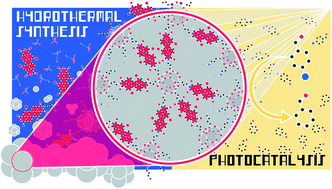Green hydrothermal synthesis yields perylenebisimide–SiO2 hybrid materials with solution-like fluorescence and photoredox activity†
Abstract
In organic–inorganic hybrid materials' (HMs) synthesis, it is intrinsically challenging to, at the same time, achieve (i) the concomitant synthesis of the components, (ii) nanoscopic interpenetration of the components, and (iii) covalent linking of the components. We here report the one-pot hydrothermal synthesis (HTS) of inorganic–organic HMs consisting of perylene bisimide (PBI) dyes and silica, using nothing but water as the medium and directly from the corresponding bisanhydrides, n-alkyl amines, and alkoxysilane precursors. First, in the absence of a functionalized alkoxysilane for linking, a mixture of the products, PBI and SiO2, is obtained. This evinces that the two products can be synthesized in parallel in the same vessel. Except for minor micromorphological changes, the concomitant synthesis does not affect each component's physicochemical properties. The PBI/SiO2 mixtures do not show synergistic properties. Second, through adding the linker aminopropyltriethoxysilane (APTS), covalently-linked class II hybrids are obtained. These PBI@SiO2 class II hybrids show synergistic materials properties: increased thermal stability is obtained in combination with nanoscopic homogeneity. The PBI moieties are dissolved in the solid SiO2 matrix, while being covalently linked to the matrix. This leads to solution-like fluorescence with vibronic fine-structure of the dyes. Moreover, through tuning the SiO2 amount, the band gaps of the class II hybrid materials can be systematically shifted. We exploit these optoelectronic properties by using the PBI@SiO2 hybrids as heterogeneous and reusable photoredox catalysts for the reduction of aryl halides. Finally, we present a detailed small-angle X-ray scattering and powder X-ray diffraction study of PBI@SiO2 synthesized at various reaction times, revealing the existence of an ordered PBI-oligomeric silesquioxane-type intermediate, which subsequently further condenses to the final nanoscopically homogeneous PBI@SiO2 material. These ordered intermediates point at HTS′ propensity to favor crystallinity (to date known for organic and inorganic compounds, respectively) to also apply to hybrid structures, and shed additional light on the long-standing question of structure formation in the early stages of sol–gel processes: they corroborate Brown's hypothesis (1965) that trifunctional hydroxysilanes form surprisingly well controlled oligomers in the early stages of polycondensation.



 Please wait while we load your content...
Please wait while we load your content...